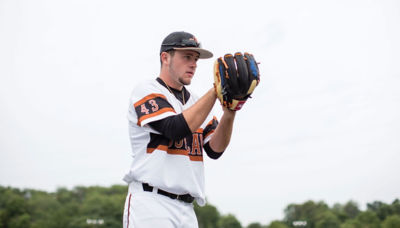How to Choose a First Baseman's Mitt
First basemen see a lot of action in the diamond, so they need a glove that will help them make plays and defeat the competition. Find out what to look for when picking the best first baseman’s mitt for you.
First basemen are perhaps the most involved position players in the game. Receiving throws from other infielders, catching pickoff attempts from pitchers and fielding their position asks a lot of a player, and more notably their glove. First base gloves are unusual when compared to other gloves seen on the field, but their design is a product of function, not fashion. Technically, first base gloves aren’t even gloves; they are mitts.
The distinction between a baseball mitt and a baseball glove comes from the fact that gloves have separated finger slots on the outside and back, while mitts are one solid piece. Aside from the catcher, first basemen are the only players permitted to wear a mitt during play. This function, similar to a catcher’s mitt, gives first basemen the added protection and larger surface area with which to field, scoop and catch.
Design among first base mitts is similar, but if you are looking for a premier fit, take into consideration the following specifications:
POCKET DEPTH AND WEBBING
Because first basemen receive more throws than most position players and do not make as many ball transfers, their mitts have a deeper pocket to withstand the high amount of catches. An open-style webbing, such as a single or dual post, gives first basemen’s mitts the ability to dig out wild throws or ground balls without bringing up large amounts of dirt.
FIRST BASEMAN MITT SIZING
First basemen’s mitts are longer and have a solid, curved edge to their design. This gives players an advantage in scooping wild throws and stopping quick ground balls down the line. The larger build of these mitts also aids in creating a larger target for infielders to throw towards.
A typical first baseman’s mitt will be between 12" and 13". Make sure to not oversize the mitt, however, as you want to be able to control it during play. This is especially vital in purchasing a first baseman’s mitt for younger players.
MATERIALS & RIGIDITY
In the same sense that you want a catcher’s mitt to be sturdy enough to withstand pitch after pitch, a first baseman’s mitt should be rigid enough to take a high number of throws as well. Your mitt should also be flexible enough to scoop errant tosses and meet basic fielding requirements. Because of these necessities, a leather material is best suited for first basemen’s mitts due to its strength and stiffness. Some synthetic gloves can be used, but the overall sturdiness of leather keeps it high in popularity among players.
Another feature to not overlook is the varying degrees of wrist adjustments. Some gloves offer an adjustable wrist opening, usually in the form of a Velcro strap, D-ring or additional lacing. These adjustment options function so that the player can create a firmer fit for their hand. Choosing which adjustment option to go with is up to player preference, as all function in the same way.
The final thing to consider when making your decision is personal comfort. Make sure to choose a mitt that you are comfortable with and confident in and can see yourself having success with.














